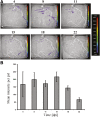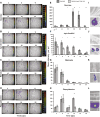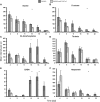Bacterial Biosensors for in Vivo Spatiotemporal Mapping of Root Secretion
- PMID: 28495892
- PMCID: PMC5490882
- DOI: 10.1104/pp.16.01302
Bacterial Biosensors for in Vivo Spatiotemporal Mapping of Root Secretion
Abstract
Plants engineer the rhizosphere to their advantage by secreting various nutrients and secondary metabolites. Coupling transcriptomic and metabolomic analyses of the pea (Pisum sativum) rhizosphere, a suite of bioreporters has been developed in Rhizobium leguminosarum bv viciae strain 3841, and these detect metabolites secreted by roots in space and time. Fourteen bacterial lux fusion bioreporters, specific for sugars, polyols, amino acids, organic acids, or flavonoids, have been validated in vitro and in vivo. Using different bacterial mutants (nodC and nifH), the process of colonization and symbiosis has been analyzed, revealing compounds important in the different steps of the rhizobium-legume association. Dicarboxylates and sucrose are the main carbon sources within the nodules; in ineffective (nifH) nodules, particularly low levels of sucrose were observed, suggesting that plant sanctions affect carbon supply to nodules. In contrast, high myo-inositol levels were observed prior to nodule formation and also in nifH senescent nodules. Amino acid biosensors showed different patterns: a γ-aminobutyrate biosensor was active only inside nodules, whereas the phenylalanine bioreporter showed a high signal also in the rhizosphere. The bioreporters were further validated in vetch (Vicia hirsuta), producing similar results. In addition, vetch exhibited a local increase of nod gene-inducing flavonoids at sites where nodules developed subsequently. These bioreporters will be particularly helpful in understanding the dynamics of root exudation and the role of different molecules secreted into the rhizosphere.
© 2017 The author(s). All Rights Reserved.
Figures







Similar articles
-
Transcriptomic analysis of Rhizobium leguminosarum biovar viciae in symbiosis with host plants Pisum sativum and Vicia cracca.J Bacteriol. 2009 Jun;191(12):4002-14. doi: 10.1128/JB.00165-09. Epub 2009 Apr 17. J Bacteriol. 2009. PMID: 19376875 Free PMC article.
-
Visualization of nodulation gene activity on the early stages of Rhizobium leguminosarum bv. viciae symbiosis.Folia Microbiol (Praha). 2005;50(4):323-31. doi: 10.1007/BF02931413. Folia Microbiol (Praha). 2005. PMID: 16408851
-
Thiamine is synthesized by a salvage pathway in Rhizobium leguminosarum bv. viciae strain 3841.J Bacteriol. 2006 Sep;188(18):6661-8. doi: 10.1128/JB.00641-06. J Bacteriol. 2006. PMID: 16952958 Free PMC article.
-
Nod factors stimulate seed germination and promote growth and nodulation of pea and vetch under competitive conditions.Microbiol Res. 2012 Mar 20;167(3):144-50. doi: 10.1016/j.micres.2011.06.001. Epub 2011 Jul 1. Microbiol Res. 2012. PMID: 21723717
-
[Oxidation processes at initial stages of interaction of root nodule bacteria (Rhizobium leguminosarum) and pea (Pisum sativum L.): a review].Prikl Biokhim Mikrobiol. 2007 Sep-Oct;43(5):576-82. Prikl Biokhim Mikrobiol. 2007. PMID: 18038678 Review. Russian.
Cited by
-
Root phenotypes as modulators of microbial microhabitats.Front Plant Sci. 2022 Sep 23;13:1003868. doi: 10.3389/fpls.2022.1003868. eCollection 2022. Front Plant Sci. 2022. PMID: 36212354 Free PMC article. Review.
-
Optical Sensing Technologies to Elucidate the Interplay between Plant and Microbes.Micromachines (Basel). 2023 Jan 12;14(1):195. doi: 10.3390/mi14010195. Micromachines (Basel). 2023. PMID: 36677256 Free PMC article. Review.
-
Insights into the Interactions among Roots, Rhizosphere, and Rhizobacteria for Improving Plant Growth and Tolerance to Abiotic Stresses: A Review.Cells. 2021 Jun 19;10(6):1551. doi: 10.3390/cells10061551. Cells. 2021. PMID: 34205352 Free PMC article. Review.
-
Long-duration environmental biosensing by recording analyte detection in DNA using recombinase memory.Appl Environ Microbiol. 2024 Apr 17;90(4):e0236323. doi: 10.1128/aem.02363-23. Epub 2024 Mar 29. Appl Environ Microbiol. 2024. PMID: 38551351 Free PMC article.
-
Conditional sanctioning in a legume-Rhizobium mutualism.Proc Natl Acad Sci U S A. 2021 May 11;118(19):e2025760118. doi: 10.1073/pnas.2025760118. Proc Natl Acad Sci U S A. 2021. PMID: 33941672 Free PMC article.
References
-
- Badri DV, Weir TL, van der Lelie D, Vivanco JM (2009) Rhizosphere chemical dialogues: plant-microbe interactions. Curr Opin Biotechnol 20: 642–650 - PubMed
-
- Baetz U, Martinoia E (2014) Root exudates: the hidden part of plant defense. Trends Plant Sci 19: 90–98 - PubMed
-
- Bais HP, Weir TL, Perry LG, Gilroy S, Vivanco JM (2006) The role of root exudates in rhizosphere interactions with plants and other organisms. Annu Rev Plant Biol 57: 233–266 - PubMed
-
- Beringer JE. (1974) R factor transfer in Rhizobium leguminosarum. J Gen Microbiol 84: 188–198 - PubMed
MeSH terms
Substances
Grants and funding
LinkOut - more resources
Full Text Sources
Other Literature Sources
Research Materials

